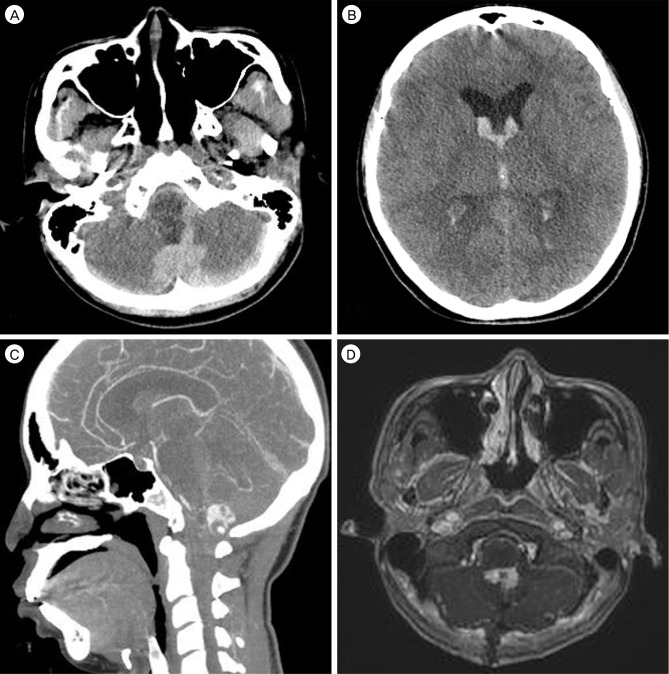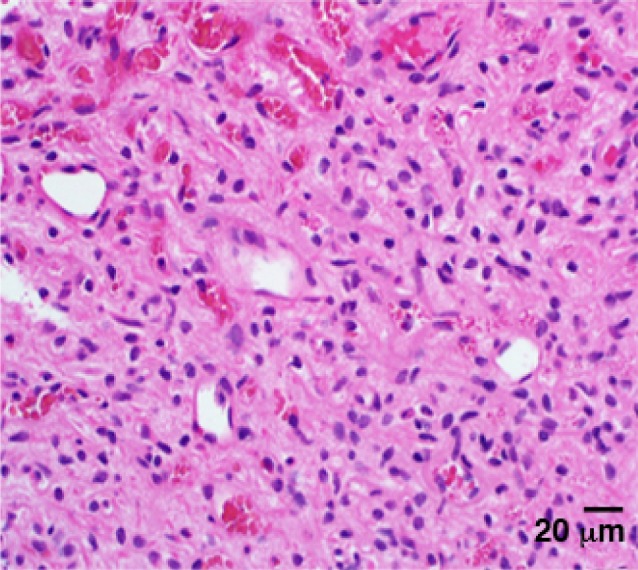J Cerebrovasc Endovasc Neurosurg.
2014 Sep;16(3):293-298. 10.7461/jcen.2014.16.3.293.
Aneurysm of the Posterior Meningeal Artery Embedded Within a Dorsal Exophytic Medullary Hemangioblastoma: Surgical Management and Review of Literature
- Affiliations
-
- 1UCSF Center for Stroke and Cerebrovascular Disease, Department of Neurological Surgery, University of California, San Francisco, CA, United States. huangm@neurosurg.ucsf.edu
- 2Neuro-Interventional Section, Department of Radiology, University of California, San Francisco, CA, United States.
- 3Department of Pathology, University of California, San Francisco, CA, United States.
- KMID: 1963170
- DOI: http://doi.org/10.7461/jcen.2014.16.3.293
Abstract
- Hemangioblastomas are World Health Organization (WHO) Grade I neoplasms of the hindbrain and spinal cord, whose management can be complicated by preoperative hemorrhage. We report on a case of a young female in extremis with posterior fossa hemorrhage following rupture of a fusiform posterior meningeal artery aneurysm embedded within a medullary hemangioblastoma. We discuss management options, including operative staging and embolization, and review similar cases of hemangioblastoma associated with aneurysm.
MeSH Terms
Figure
Reference
-
1. Aldape KD, Plate KH, Vortmeyer AO, Zagzag D, Neumann HPH. Hemangioblastoma. In : Louis DN, Ohgaki H, Wiestler OD, Cavenee WK, editors. WHO Classification of tumours of the central nervous system. 4th ed. Lyon: International agency for research on cancer (IARC);2007. p. 184–186.2. Aronson JP, Murray PJ, Ogilvy CS. Rupture of a pseudoaneurysm of the posterior meningeal artery at its anomalous origin from the posteroinferior cerebellar artery: case report. Neurosurgery. 2008; 9. 63(3):E608. discussion E608. PMID: 18812940.3. Campos WK, Linhares MN. Sporadic intramedullary spinal cord hemangioblastoma in a newborn. Pediatr Neurosurg. 2010; 11. 46(5):385–389. PMID: 21389752.
Article4. Chang SW, Kakarla UK, Sharma GK, Spetzler RF. Posterior inferior cerebellar artery origin thrombosis with aneurysm of collateralized posterior meningeal artery presenting as subarachnoid hemorrhage: case report. Neurosurgery. 2009; 10. 65(4):E818–E819. PMID: 19834362.5. Cornelius JF, Saint-Maurice JP, Bresson D, George B, Houdart E. Hemorrhage after particle embolization of hemangioblastomas: comparison of outcomes in spinal and cerebellar lesions. J Neurosurg. 2007; 6. 106(6):994–998. PMID: 17564170.
Article6. Cushing H, Bailey P. Tumors arising from blood vessels in the brain: angiomatous malformations and hemangioblastomas. Springfield, IL: Charles C Thomas;1928.7. de San Pedro JR, Rodríguez FA, Níguez BF, Sánchez JF, López-Guerrero AL, Murcia MF, et al. Massive hemorrhage in hemangioblastomas Literature review. Neurosurg Rev. 2010; 1. 33(1):11–26. PMID: 19672640.8. Drake CG, Peerless SJ. Giant fusiform aneurysms: review of 120 patients treated surgically from 1965 to 1992. J Neurosurg. 1997; 8. 87(2):141–162. PMID: 9254076.9. Elhammady MS, Wolfe SQ, Ashour R, Farhat H, Moftakhar R, Lieber BB, et al. Safety and efficacy of vascular tumor embolization using Onyx: is angiographic devascularization sufficient? J Neurosurg. 2010; 5. 112(5):1039–1045. PMID: 19698039.
Article10. Goetz F, Lanfermann H, Nakamura M, Krauss JK, Hong B. Life-threatening hemorrhage from a traumatic aneurysm of the posterior meningeal artery: treatment with coil embolization. Cent Eur Neurosurg. 2011; 8. 72(3):162–165. PMID: 20491001.
Article11. Guzman R, Grady MS. An intracranial aneurysm on the feeding artery of a cerebellar hemangioblastoma. Case report. J Neurosurg. 1999; 7. 91(1):136–138. PMID: 10389894.12. Menovsky T, André Grotenhuis J, Bartels RH. Aneurysm of the anterior inferior cerebellar artery (AICA) associated with high-flow lesion: report of two cases and review of literature. J Clin Neurosci. 2002; 3. 9(2):207–211. PMID: 11922719.13. Montano N, Doglietto F, Pedicelli A, Albanese A, Lauretti L, Pallini R, et al. Embolization of hemangioblastomas. J Neurosurg. 2008; 5. 108(5):1063–1064. PMID: 18447734.
Article14. Muro K, Adel JG, Gottardi-Littell NR, Getch CC, Batjer HH. True aneurysm on the posterior meningeal artery associated with a dural arteriovenous fistula: case report. Neurosurgery. 2010; 9. 67(3):E876–E877. PMID: 20657313.15. Ogawa T, Fujita H, Inugami A, Shishido F, Higano S, Uemura K. Anomalous origin of the posterior inferior cerebellar artery from the posterior meningeal artery. AJNR Am J Neuroradiol. 1991; Jan-Feb. 12(1):186. PMID: 1899510.16. Okuno S, Touho H, Ohnishi H, Karasawa J. Ruptured aneurysm at the bifurcation of the posterior meningeal artery from the proximal posterior inferior cerebellar artery. Acta Neurochir (Wien). 1998; 7. 140(6):629–630. PMID: 9755334.
Article17. Seong Eom K, Won Kim D, Sung Choi S, Ha Choi K, Young Kim T. Preoperative embolization of a cerebellar hemangioblastoma using Onyx: case report and literature review. Neurol Neurochir Pol. 2011; May-Jun. 45(3):292–296. PMID: 21866486.18. Tanohata K, Maehara T, Noda M, Katoh H, Sugiyama S, Okazaki A. Anomalous origin of the posterior meningeal artery from the lateral medullary segment of the posterior inferior cerebellar artery. Neuroradiology. 1987; 1. 29(1):89–92. PMID: 3822110.
Article19. Tsutsumi M, Kazekawa K, Aikawa H, Iko M, Kodama T, Nii K, et al. Development of unusual collateral channel from the posterior meningeal artery after endovascular proximal occlusion of the posterior inferior cerebellar artery. Neurol Med Chir (Tokyo). 2007; 11. 47(11):503–505. PMID: 18037804.20. Vates GE, Berger MS. Hemangioblastomas of the central nervous system. In : Winn HR, editor. Youmans Neurological Surgery. 5th ed. Philadelphia: Saunders;2004. p. 1053–1066.21. Zager EL, Shaver EG, Hurst RW, Flamm ES. Distal anterior inferior cerebellar artery aneurysms. Report of four cases. J Neurosurg. 2002; 9. 97(3):692–696. PMID: 12296656.
- Full Text Links
- Actions
-
Cited
- CITED
-
- Close
- Share
- Similar articles
-
- Traumatic middle meningeal artery pseudoaneurysm: Case report and review of literature
- A Case of Posterior Medullary Hemangioblastoma
- Supratentorial Meningeal Hemangioblastoma: Case Report
- Aneurysm of Distal Posterior Inferior Cerebellar Artery:Case Report with Review of the Literature
- Posterior Inferior Cerebellar Artery Aneurysm, Mimicking Lateral Medullary Infarction: A Case Report




